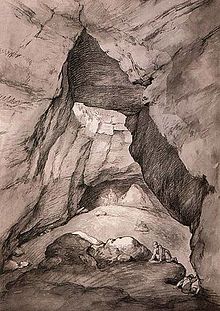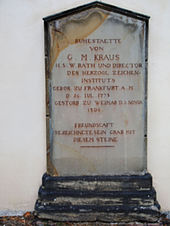Georg Melchior Kraus
Georg Melchior Kraus (born July 26, 1737 in Frankfurt am Main , † November 5, 1806 in Weimar ) was a German artist . He was a student of Johann Heinrich Tischbein the Elder , painter , teacher and entrepreneur and was friends with Johann Wolfgang von Goethe . He is one of the equally well-known and popular German visual artists of the 18th century.
Life
Georg Melchior Kraus was born as the sixth of nine children. Five of his siblings died before they reached their first year of life. His parents Cornelia geb. Paulsen and Johann Georg Kraus ran the inn "Zur weissen Schlangen" in Sandgasse in Frankfurt. The boy was eight years old when his father remarried after the early death of his mother.
From 1759 to 1762 the court painter Johann Heinrich Tischbein the Elder trained Landgrave Friedrich II. Georg Melchior Kraus as a painter at the Kassel court in his studio. In November 1762 Kraus traveled to one of the most important engravers of the time, Johann Georg Wille in Paris, where he also met the genre painter Jean-Baptiste Greuze . In Paris he carried the title of “peintre de genre familier de S.A. S. le prince Evêque de Wirsbourg”.
At the end of 1766 Kraus returned to Frankfurt and initially worked as a private drawing teacher and genre painter. He maintained his contacts in France, so he was listed as a genre painter on the Colisée list in 1776. In Frankfurt he also gave drawing lessons to Johann Wolfgang von Goethe in addition to Sophie von La Roche , Friedrich Heinrich Jacobi and others . In a petition to the council of the imperial city of April 2, 1767, he tried in vain to establish a painting academy. Several years followed in which he moved to changing clients and kept returning to Frankfurt. Through the advocacy of his Parisian fellow student Jacob Matthias Schmutzer , Kraus became an external member of the “freye Kaiserl. Royal Copper Engraving Academy ”in Vienna. In the summer of 1770 he traveled to Switzerland for a year and a half, then the stays that led him to Erfurt changed again.
It was there in 1773 that Kraus made contact with personalities such as Christoph Martin Wieland and Friedrich Justin Bertuch , who introduced him to the Weimar court. After several short visits, Kraus moved permanently to Weimar in autumn 1775. Apart from short trips, he spent the entire second half of his life there. He made friends with Bertuch, who at the time was the secret secretary and case manager of the young Duke Carl August von Sachsen-Weimar . Together, Kraus and Bertuch submitted a memorandum in Weimar in 1774 “Draft of a free drawing school to be set up here with few resources”. In 1775, on a visit to his home town of Frankfurt, he taught Goethe about Weimar conditions, even before the latter received an invitation from Duke Carl August, who founded and financed the “ Princely Free Drawing School ” in Weimar as one of his first official acts in 1776 . Georg Melchior Kraus was appointed the first director and held this position until his death. Besides him, u. a. the sculptor Martin Gottlieb Klauer and the painters Konrad Horny and Johann Ernst Heinsius . In 1784 Kraus accompanied Johann Wolfgang von Goethe on his third trip to the Harz Mountains (August 8 to September 14, 1784) in order to record geological studies in drawings.
In 1786 Georg Melchior Kraus and the bustling publisher Johann Friedrich Justin Bertuch, who was also the owner of a flourishing flower and haberdashery factory founded in 1780, published the journal of fashions , for which Kraus created the partly colored copper plates for every issue or through his drawing school that added to the value of the magazine. Cosmopolitan and skillful, both understood how to quickly make the journal known and popular beyond the borders of Germany and to make it one of the most successful journalistic companies of that time.
Driven by success, Bertuch started the picture book for children in 1790 , for which Kraus and his drawing school also made the copperplate engravings. One of the engravers who worked for him was Johann Christian Ernst Müller . Kraus was generally welcomed in Weimar circles. "Young and old, court and citizenship, councilors, poets and nobility, pages and their tutors sat next to each other, parents learned at the same time with their children." (Felix Pischel). In the winter of 1781/1782, Goethe gave lectures on anatomy. He said of Kraus: “He himself was the most pleasant company; indifferent cheerfulness accompanied him thoroughly; ready for duty without humility, held without pride, he found himself at home everywhere ... “Goethe often took Kraus with him on his travels to Thuringia, the Harz Mountains and also to Mainz, where he sketched the siege of the city (picture in the Landesmuseum Mainz ).
In 1806, after Napoleon's victory in Jena and Auerstedt , French soldiers overran and plundered Weimar. They also raided Krausen's house. Bertuch's friend took the wounded painter in and cared for him, but he only survived his injuries by a few weeks. Kraus died on November 5, 1806 at the age of 69 in Weimar, where he was buried in the Jacobsfriedhof Weimar .
gallery
The Hübichenstein in the Harz Mountains in 1784
The Klause near Goslar ( Klusfelsen ) 1784
Rammelsberg 1784
Anna Amalia von Braunschweig-Wolfenbüttel , Duchess of Saxe-Weimar-Eisenach
Duchess Luise of Hessen-Darmstadt
Lover's performance of the “Mail Train” by Ayrenhoff
The powder tower and the Johannistor in Jena
Fonts
- ABC of the draftsman, by GM Kraus, Herzogl. SW Rath and Director of the herzogl. Free drawing school in Weimar. 5th edition. Weimar 1810.
- Prospects and parts of the Duke. Parks near Weimar. Edited by Ernst-Gerhard Güse and Margarete Oppel. Weimar 2006, ISBN 3-7443-0137-0
literature
- Ernst Beutler : Georg Melchior Kraus. In: Ders .: Essays on Goethe. Bremen 1957, pp. 417-443.
- Lionel von Donop : Kraus, Georg Melchior . In: Allgemeine Deutsche Biographie (ADB). Volume 17, Duncker & Humblot, Leipzig 1883, p. 72 f.
- Birgit Knorr: Georg Melchior Kraus (1737-1806). Painter - educator - entrepreneur. Biography and catalog raisonné. Dissertation, University of Jena 2003 ( full text ).
- Christina Kröll: Kraus, Georg Melchior. In: New German Biography (NDB). Volume 12, Duncker & Humblot, Berlin 1980, ISBN 3-428-00193-1 , p. 686 ( digitized version ).
- Fritz Kühnlenz: The painter - Georg Melchior Kraus. In: Ders .: Weimar portraits. Men and women around Goethe and Schiller. Rudolstadt 1961, pp. 347-360.
- Gisold Lammel: Georg Melchior Kraus - picture chronicler in the Weimar of the Enlightenment and Classic. In: Ders .: Daydreams. Images in the light of the Enlightenment. Amsterdam 1993, p. 185, 193.
- Christine Meissner, Markus Meissner: In the freedom of the mountains - In Goethe's footsteps in the Harz Mountains. Weimar 1989.
- Konrad Paul: The first hundred years 1774–1873. On the history of the Weimar school of painting and drawing. Weimar 1996.
- Eberhard Freiherr Schenk zu Schweinsberg : Directory of the etchings by Georg Melchior Kraus. In: Yearbook of the Kippenberg Collection, Vol. 7, 1927/1928, pp. 277-302. (Supplements in: Yearbook of the Kippenberg Collection, Vol. 10, pp. 316-318).
- Eberhard Freiherr Schenk zu Schweinsberg: Georg Melchior Kraus. Weimar 1930 (= writings of the Goethe Society, 43rd volume).
- Hans Wahl , Anton Kippenberg : Goethe and his world. Insel-Verlag, Leipzig 1932, pp. 45, 56, 58f, 79f, 87, 95, 131, 139.
Web links
- Literature by and about Georg Melchior Kraus in the catalog of the German National Library
- Works by and about Georg Melchior Kraus in the German Digital Library
- Works by Georg Melchior Kraus at Zeno.org .
- Calendar sheet of the BR about Georg Melchior Kraus ( Memento from September 30, 2007 in the Internet Archive )
- History of the painting and drawing school in Weimar
- Publishing collaboration with Johann Friedrich Justin Bertuch
- Alt-Weimar in views by Georg Melchior Kraus
- Works by Georg Melchior Kraus in the Städelmuseum Frankfurt am Main
| personal data | |
|---|---|
| SURNAME | Kraus, Georg Melchior |
| BRIEF DESCRIPTION | German painter, educator and entrepreneur |
| DATE OF BIRTH | July 26, 1737 |
| PLACE OF BIRTH | Frankfurt am Main |
| DATE OF DEATH | November 5, 1806 |
| Place of death | Weimar |















